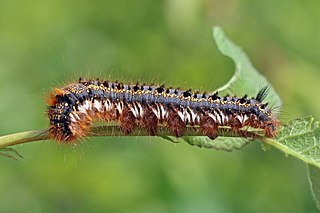 Caterpillars of the Drinker moth can be seen emerging in the spring, getting ready to pupate in June. Look for the tuft of hair at each end.
Caterpillars of the Drinker moth can be seen emerging in the spring, getting ready to pupate in June. Look for the tuft of hair at each end.
Photo: Charles J Sharp (via Wikimedia Commons)
Scientific name: Euthrix potatoria
Cornish name: ‘Gouwan’ is the general word for moth
What to look for:
- Colouring: Adult females are yellowish, and the smaller males are a more orange-brown colour. Caterpillars are black, orange and white.
- Size: Adult wingspan is up to 6.5 cm.
- Where: Damp grassland and heaths, fens, though sometimes found on drier grassland.
- Similar species: Other moths of the Eggar family. The caterpillar is fairly distinctive given its colouring.
 The Drinker, a common nocturnal moth in southern parts of Britain, flies in July and August. Fairly large, with a wingspan of up to 6.5 cm, it is a member of the Eggar moth family (Lasiocampidae). Males and females look a little different: the females are more yellow and are larger than the orange-brown males. Both males and female show the strong line crossing the forewing (clearly shown in the photograph below) and two white spots, also on the forewing.
The Drinker, a common nocturnal moth in southern parts of Britain, flies in July and August. Fairly large, with a wingspan of up to 6.5 cm, it is a member of the Eggar moth family (Lasiocampidae). Males and females look a little different: the females are more yellow and are larger than the orange-brown males. Both males and female show the strong line crossing the forewing (clearly shown in the photograph below) and two white spots, also on the forewing.
It is perhaps however the caterpillar that is more familiar. It overwinters as a small larva, emerging again in spring to grow to a large black, orange and white caterpillar, distinguished by two hair tufts, one at each end, that look like horns. Coarse grasses and reeds are the main foodplant.
 Did you know…?
Did you know…?
…The caterpillar is supposed to have a liking for drinking dew, giving it its common name. The species name potatoria is also from the Latin for ‘drink’.
…A long-term study of larger moths (Butterfly Conservation, 2013) revealed serious population declines across the majority of species surveyed. The Drinker, originally one of the declining species, has however more recently shown a significant increase.
More information and references:
Butterfly Conservation, 2013. The State of Britain’s Larger Moths 2013. Butterfly Conservation, Wareham, Dorset.
Chinery, M., 2005. Collins Complete Guide to British Insects. Collins, London.
Waring, P., Townsend, M. and Lewington, R., 2009. Field Guide to the Moths of Great Britain and Ireland (second edition). British Wildlife Publishing, Gillingham, Dorset.
Published: May 2014
Author: Amanda Scott
Photos: Adult moth (Lairich Rig [CC-BY-SA-2.0]); caterpillar (Charles J Sharp [CC BY-SA]), both via Wikimedia Commons
